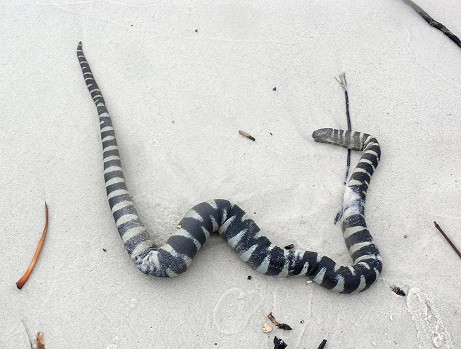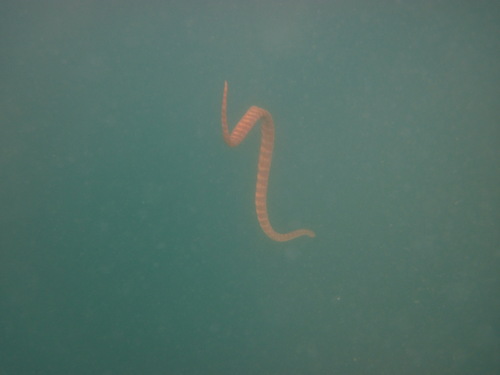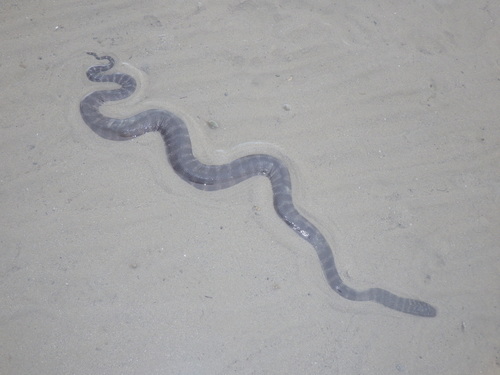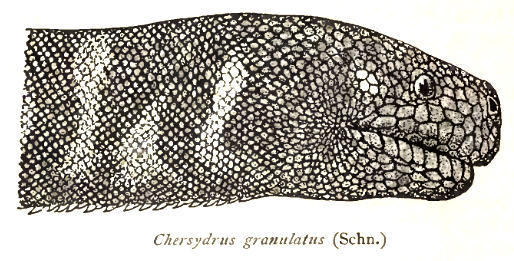| 1 | Cousin of the elephant trunk snake |

One of the most popular “weird” snake species is undoubtedly the elephant trunk snake of south-east Asia. This is a thick, grey-coloured snake with warty-looking scales that appear to be hanging off its body. It constantly appears in lists of the weirdest looking snakes, but it also has a less famous cousin called the little filesnake (or banded filesnake).
Acrochordus granulatus is the third member of the Acrochordus family, and appears in the widest range, from the north-east Indian coast all the way to Australia. It’s easily the smallest member of the family, averaging at 51-71cm compared to the elephant trunk’s 2 metres and the Arfura filesnake’s 1.7 metres. It’s so different from the other 2 species that upon discovery in 1799, the little filsenake was assigned to its own family of Chersydrus instead.
Up close, its scales share the same roughness and wartiness – it’s not a snake you would want to stroke lovingly. But there’s one obvious visual difference, in that little filesnakes have a series of neat, evenly spaced stripes on their bodies. There’s 50-60 per snake, and they’re usually a lighter cream colour, compared to the grey of its underscales. This is a tighter, sleeker serpent, whose scales are still loose but not hanging off its body.
| 2 | Appears 6 miles out to sea |

The biggest difference is that of the three Acrochordus members, the little filesnake is by far the most aquatic. All 3 dwell in water almost exclusively. The elephant trunk snake prefers freshwater habitats like lakes and estuaries, and is commonly picked up by Malaysian fishermen in wooden boats sailing along rivers. The little filesnake also inhabits these inland habitats, but is far more likely to be found out to sea where swimmers and small boats rarely sail. Little filesnakes have been observed 6 miles out to sea before, sometimes at depths of 60 feet.
The little filesnake is even more useless on land than the elephant trunk snake. They spend the first days of their lives on land as babies, but as adults, their warty skin prevents them from slithering; it’s more of a mummy-like shuffle.
In water, they’re an entirely different beast. They’re Olympic level swimmers which are proven to withstand both fast and slow currents. In the fast currents, they sometimes fix themselves to the seabed using their rough, diamond-like scales to maximise friction.
| 3 | Superblood in its veins |

The little filesnake has numerous adaptions to aid its underwater life, and one of them is ultra thick blood. Compared to normal snakes, the little filesnake has twice as many red blood cells per gram of blood, which allows it to carry significantly more oxygen. This allows the species to stay underwater for hours at a time, only surfacing to breath with the nostrils on top of its head very occasionally.
The species has twice as much blood in its veins overall, and its haemoglobin has an unusually high affinity for oxygen molecules. Little filesnakes also have the ability to synthesise oxygen from acidic carbon dioxide molecules found underwater.
The end result of these adaptions, earned over millions of years of patient evolution, is that a little filesnake’s body can store 3-15 times as much oxygen as sea snakes of a similar weight. They also release oxygen more slowly, and they share these adaptions with many species of turtle.
| 4 | Ocean-adapted salt glands |
Another difference to the other two filesnake species is a shorter, more compressed tail. Then there’s an adaption which cements its position as king of the ocean once and for all: a salt-removing gland beneath its tongue.
Without this handy gland, the little filesnake would rapidly become dehydrated and lose the ability to eat. It’s extremely similar to the salt glands found in true sea snakes (Hydrophiidae), but evolved independently, as the two families are only distantly related. In fact, the little filesnake’s salt glands are superior to many true snakes, removing a higher quantity of sodium per minute. These glands are missing from the other two Acrochordus species.
The system isn’t infallible, as the gland isn’t enough to prevent dehydration completely. Every so often, little filesnakes are forced to return to inland freshwater habitats like estuaries to replenish their moisture. Sometimes, they use a cheat code instead and absorb freshwater from rainfall, which lingers on the ocean surface for a while due to its lighter weight than salt water. Filesnakes instinctively know this scientific secret.
| 5 | A genetic anomaly |

In our article on elephant trunk snakes, we discussed the family’s evolution, how they had an ancient relative 10 million years ago called acrochordus dehmi. As of 2022, scientists believe that acrochordus may be one of the most isolated snake families on the whole evolutionary tree. Their freakish warty scales are evidence enough, but there’s one more subtle sign: a total lack of a bone called the metotic fissure.
The job of this bone is to connect the ears to the brain cavity and deliver sound waves. The vibrations run along this small hidden bone, resulting in more accurate hearing, and more accurate hunting. The metotic fissure is found in all 3000 species of snake in the world, with the sole exception of the 3 Acrochordus species.
They’re even placed within their own superfamily, Acrochordoidea, of which acrochordus is the only subfamily. It’s believed that this archaic line split off before the “advanced” families of snakes evolved, the modern-day colubrids, elapids, and viperids. Either way, the evidence is strong that the banded filesnake split off from the other two species 16-20 million years ago.
| 6 | Threatened by heavy ocean trawlers |

The little filesnake isn’t known to be endangered, but their leathery skin is coveted for making handbags, shoes and wallets. Some fishermen hunt them for their meat, and from 1984-1990, 1.2 million little filesnakes were exported from Indonesia. 30,000 were sold to America, while the rest vanished into the underworld.
Figures have been thin on the ground since then, so it may have been a passing craze, but in 2017, the Hindustan times published an article detailing the recklessness of the Indian fishing industry. The new generation of industrial sea trawlers were scraping up snakes from the seabed en masse, prowling forward slowly yet relentlessly. One of the hardest hit places was the Mumbai coast, a known stronghold for little filesnakes. Figures weren’t given for the little filesnake, but the Shaw’s sea snake was shown to have declined strongly from 2004 to 2019.
The saving grace is that this heavy machinery doesn’t exist yet in most of their Southeast Asian ranges. Little filesnakes are remote enough and small enough (smaller than blue whales anyway) that they can probably slip through the cracks. They’re still common in their old ranges, and in certain areas they’re abundant.
| 7 | Male-female differences |
Like many snakes, the females of this species are larger than the males, but only by a slight amount. The grey and white striped scales are also very similar; there’s no comparison to the Antiguan racer snake where females have a totally different colour scheme, silver instead of brown.
Instead, the little filesnake has a completely different hunting style between the sexes. While males are active foragers and swim around searching for fish, females are ambush predators and lie in wait. Technically, filesnakes are constrictors, but they don’t asphyxiate their prey; the coils they form are only used to hold the predator in place. Like the elephant trunk snake, their rough scales are perfectly designed for holding slippery, slimy fish.
Being the smallest of its family, you might expect the little filesnake to give birth to a huge clutch of babies to compensate. But no, the little filesnake lays an average of 6 young, compared to 30 for the elephant trunk snake, a low number for any snake species.
| 8 | Diet: gobies and sleeperfish |
Lizards are out of bounds for the little filesnake, and the only mammals in the nearby ocean are dolphins and whales. They’re too small to leap from the sea surface and snatch a pelican gliding past, so the bulk of their diet consists of fish. Scientists have also found crustaceans and small fragments of snails in their stomachs.
The elephant trunk snake prefers catfish, but being smaller itself, the little filesnake is forced to rely on smaller fish such as sleeperfish and members of the gobie family. In one study, scientists analysed 9 dead Acrochordus granulatus specimens from Sungai Buloh. One 63.5cm snake contained a whole 6.5cm sleeperfish, while a 58.7cm and a 64.5cm snake each contained a 5.5cm gobie.
These fish species have particular hideouts, sticking to underwater rock crevices and burrows. This has forced the little filesnake to evolve a particular foraging strategy. Rather than prowling the sea floor aimlessly, little filesnakes deliberately seek out these crevices, where other sea creatures may be peeking out watchfully. Gobies are a particularly shy fish family, disappearing in a flicker of fins and scales, and this age old conflict with Acrochordus granulatus might be why.
| 9 | Senses oncoming water currents |

The banded filesnake is similar to its elephant trunk cousin in that it has some of the most advanced scales in the world. Like a volcano that conceals a hidden base, each of its tiny round protrusions conceals tiny bristle-like structures. These are each attached to a bundle of nerves at the scale’s base, with hundreds of replicas across its body.
This gives the snake the unusual ability to detect currents and the movement of prey through water. Not only do the sandpaper like scales hold fish in place, they signal the fish’s movements and let the snake react accordingly.
All 3 Acrochordus species are nocturnal, and during the day, the banded file snake buries itself in mud amid thick grasses. This acts as a disguise against the snake’s handful of predators, one of which is the white-bellied sea eagle. This bird with a 2 metre wingspan inhabits the banded filesnake’s entire range, from the coasts of southern India to northern Australia. It’s a terror of the skies which swoops down and picks up fish with a single claw, but also snakes on the seabed if its eyesight happens to be keen enough that day.
| 10 | A poor captive pet |
It’s said that the little filesnake fares poorly in captivity. The oldest ever corn snake reached 32 years, but the maximum for banded filesnakes is only 5 years. Their enclosures require many minute adjustments for water quality, and the water temperature has to be kept to 27-30C, and never below 25. It’s also difficult to craft an enclosure which mimics the nooks and crannies they naturally encounter in the wild.
Herpetologists advise keeping the water salt concentration to 70%, and changing the water constantly. It’s a large task, with the only redeeming factor being that they’re non-fussy eaters which will happily wolf down most small fish you throw at them.
Additionally, reptile enthusiasts have noticed how it’s possible to place several banded filesnakes in an enclosure at once. They don’t nuzzle each other lovingly, or form any type of bond, but they don’t become aggressive and attack each other either. When food is dropped into an enclosure, multiple banded filesnakes will sometimes feed from the same source. If anything, they seem indifferent to their fellow kind.
